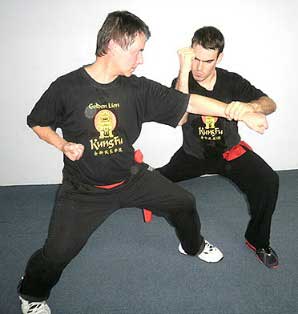Dim Mak pressure point Three Heater 10 is not a dangerous point, it is not a point that causes serious injury or death. It is the milder of the two points on the back of the upper arm. Below is an account of its effectiveness.
The Dai Sifu’s (Grandmaster Dr Pier Tsui-Po) classes in Dim Mak focus on pressure points for self-defence, they are very informative, challenging and incredibly fun. Recently, I was provided with firsthand experience of what it actually feels like when a particular point is struck in the correct manner and the resulting effects on the body.
Our training programme then was about “putting your feet into position”, a process of transitioning between side dragon stances while moving forward, adding power generated through legs and waist movement to maximise the power of the strike.
On the 16th of February we applied these movements to defend against an opponent’s straight punch with the potential of breaking the arm at the elbow joint. One of the dim mak points to focus on was Three Heater 10. We started with a left side forward fighting stance. We then moved our right “foot into position” into a dragon stance while using an outside tiger claw to seize, finishing with a forearm strike to the upper arm at Three Heater 10 (TH 10) . The movement of waist and hips is used to add power to the strike while destabilizing the opponent.
I paired with Si Jie Joey of the Murrumbeena kung fu academy for this application, and she executed the technique perfectly, landing a strike directly onto point Three Heater 10. Here’s what happened to me.
A Case for Pressure Point Three Heater 10

The effects were immediate and although my body barely registered the impact, the results were instantaneous. It was totally different from any other strikes that I experienced before. My arm lost sensation and any attempts at moving it were met with a great deal of pain, this spread completely evenly along the entire length of my arm. I had to stop and try to recover from the pain but I quickly found out that it was just the beginning.
I felt blood start to drain from my head, my vision tunnelled and pixelated. Simultaneously my stomach churned as if someone had just turned it into a blender and switched it on to full speed, which made me think I would soon be running to a window (to vomit). Thankfully, the Dai Sifu paused the class to tell us more about the points that we were working on and their precise locations. While standing there listening to Dai Sifu, the effects of TH10 continued, I soon found myself fighting my body’s need to sit down.
Just as I thought I was fighting a losing battle and my intimacy with the floor was becoming imminent, the effects of the strike reached their crescendo and very slowly my body began to stabilise. The next day I noticed that I had two, quite noticeable, red marks on the top of my cheek bone below each eye. I had not been hit on the face.
Pressure point Three Heater 10 is not a dangerous point, I mean it is not a point that causes serious injury or death. It is one of two points on the back of the upper arm that the Dai Sifu teaches for this type of technique. TH10 is the milder of the two points.
When I spoke to Dai Sifu about my experience, he explained that the effects I felt were due to the large disruption in the movement of my Chi; the resulting chaotic behaviour of Chi moving up and down my body incorrectly, unable to settle. He said the nature of the Three Heater channel is to facilitate the movement of Chi up and down the body. The vomiting was the three heater disrupting the downward movement of stomach Chi, which moves Chi downwards so the disruption caused the Chi to rise instead. The two red marks that were left under my eyes showed the effect on the Stomach channel, they were indicative of the heat rising in my body caused by the damage to my Yang Chi. I fully recovered from the effects of TH10 a day later with no problems with my arm or elbow.
I’ve heard that the best way to really understand or know about a technique is to feel it; well, that was truly an enlightenment of just a pressure point technique, not punishment from Si Jie Joey.
Overall this was a very informative experience of just how effective Dim Mak self-defence pressure points can be when executed in the correct and accurate manner.
Thanks to Jesse Cox for this contribution.
